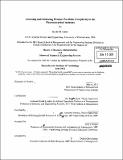Assessing and reducing product portfolio complexity in the pharmaceutical industry
Author(s)
Leiter, Kevin M. (Kevin Michael)
DownloadFull printable version (9.909Mb)
Other Contributors
Leaders for Global Operations Program.
Advisor
Roy Welsch and Anthony Sinskey.
Terms of use
Metadata
Show full item recordAbstract
Overly complex product portfolios lead to inefficient use of resources and limit an organization's ability to react quickly to changing market dynamics. The challenges of reducing portfolio complexity are defining excess complexity, identifying it in the portfolio, and removing it while still delivering value to customers. Novartis Pharmaceuticals, in agreement with the prevalent operational excellence culture, is exploring complexity reduction as a mechanism to reduce waste, costs, and inventory levels. This thesis proposes the use of a comprehensive complexity reduction approach which targets both large and tail-end products for rationalization. The first complexity reduction focus area, redundant product rationalization, targets medium to large stock keeping units that do not directly satisfy a unique customer requirement. Removing redundant products has two benefits. First, larger products consume more resources, so the cost savings associated with removing a large redundant product are greater than that of smaller products. Second, sales levels will be preserved, as the demand for the rationalized product will shift to the remaining products that still meet the customer requirement in question. The second focus area is the more traditional tail-end pruning. By removing smaller, less profitable products and product groups, critical resources can be reallocated to more profitable products or new product launches. Novartis has piloted and partially implemented this approach with impressive results. With the support of influential leaders across all functions, Novartis is expecting a reduction of 15% of the portfolio in terms of number of finished product stock keeping units and a reduction of up to $22 million USD in inventory value. Other benefits include improvements in demand forecast accuracy, production write-offs, asset utilization, and replenishment lead times.
Description
Thesis (M.B.A.)--Massachusetts Institute of Technology, Sloan School of Management; and, (S.M.)--Massachusetts Institute of Technology, Engineering Systems Division; in conjunction with the Leaders for Global Operations Program at MIT, 2011. Cataloged from PDF version of thesis. Includes bibliographical references (p. 65-66).
Date issued
2011Department
Leaders for Global Operations Program at MIT; Massachusetts Institute of Technology. Engineering Systems Division; Sloan School of ManagementPublisher
Massachusetts Institute of Technology
Keywords
Sloan School of Management., Engineering Systems Division., Leaders for Global Operations Program.